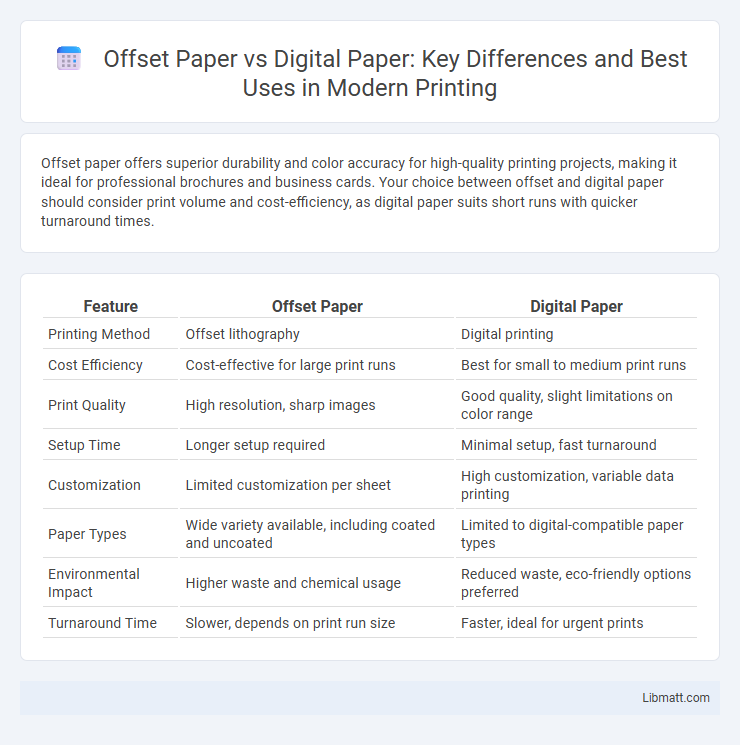Offset paper offers superior durability and color accuracy for high-quality printing projects, making it ideal for professional brochures and business cards. Your choice between offset and digital paper should consider print volume and cost-efficiency, as digital paper suits short runs with quicker turnaround times.
Table of Comparison
| Feature | Offset Paper | Digital Paper |
|---|---|---|
| Printing Method | Offset lithography | Digital printing |
| Cost Efficiency | Cost-effective for large print runs | Best for small to medium print runs |
| Print Quality | High resolution, sharp images | Good quality, slight limitations on color range |
| Setup Time | Longer setup required | Minimal setup, fast turnaround |
| Customization | Limited customization per sheet | High customization, variable data printing |
| Paper Types | Wide variety available, including coated and uncoated | Limited to digital-compatible paper types |
| Environmental Impact | Higher waste and chemical usage | Reduced waste, eco-friendly options preferred |
| Turnaround Time | Slower, depends on print run size | Faster, ideal for urgent prints |
Introduction to Offset Paper vs Digital Paper
Offset paper is specially designed for traditional offset printing processes, featuring high opacity, smooth texture, and excellent ink absorption for sharp, durable prints. Digital paper, optimized for digital printing technologies such as laser and inkjet, offers consistent quality with coatings that enhance toner adhesion and prevent smudging. The choice between offset and digital paper depends on factors like print volume, cost efficiency, and desired print quality.
What is Offset Paper?
Offset paper is a high-quality, uncoated paper designed specifically for offset printing, where ink is transferred from a plate to a rubber blanket before being applied to the paper. It offers excellent ink absorption and durability, making it ideal for producing sharp images and fine details in books, magazines, and brochures. Choosing offset paper ensures your printed materials achieve vibrant colors and crisp, professional results.
What is Digital Paper?
Digital paper refers to electronic devices or software that simulate the experience of writing or drawing on traditional paper while providing the benefits of digital technology. Unlike offset paper, which is a physical medium used in printing with high-quality ink transfer, digital paper allows you to create, edit, and store documents electronically, enhancing flexibility and reducing physical waste. By using digital paper, Your workflows become more efficient, enabling easy sharing, archiving, and searching of handwritten or typed content.
Key Differences Between Offset and Digital Paper
Offset paper is designed for traditional lithographic printing processes and typically offers higher quality, better color consistency, and a wider range of paper types and finishes compared to digital paper. Digital paper is optimized for inkjet or laser printers, supporting faster turnaround times, variable data printing, and lower setup costs but may have limitations in color accuracy and paper durability. Key differences include offset paper's superior print quality and longevity versus digital paper's flexibility and efficiency in short print runs.
Print Quality Comparison
Offset paper delivers superior print quality with sharp images, vibrant colors, and consistent ink distribution due to its use in traditional offset printing processes. Digital paper, used in digital printing, often shows slight variations in color accuracy and image sharpness but offers faster turnaround and cost efficiency for short runs. High-resolution digital printers have narrowed the quality gap, yet offset printing remains preferred for premium print projects requiring the highest fidelity.
Cost Efficiency and Scalability
Offset paper offers cost-efficiency in large print runs due to economies of scale, making it ideal for high-volume productions. Digital paper printing provides greater scalability for small to medium quantities, eliminating setup costs and reducing waste. Businesses must weigh initial investment and volume demands to determine the most cost-effective and scalable printing solution.
Environmental Impact and Sustainability
Offset paper production consumes significant water, energy, and chemicals, contributing to deforestation and pollution, whereas digital paper reduces physical resource use but relies on electricity and electronic devices with their own environmental footprint. You can lower your ecological impact by opting for recycled or FSC-certified offset paper and minimizing unnecessary printing. Digital paper offers sustainable benefits when paired with energy-efficient devices and responsible e-waste management, balancing convenience with environmental responsibility.
Best Applications for Offset Paper
Offset paper excels in high-volume printing projects such as magazines, brochures, books, and marketing materials due to its superior print quality, durability, and cost-effectiveness for large runs. This type of paper offers excellent ink absorption and color fidelity, making it ideal for detailed images and vibrant graphics. Your choice of offset paper ensures professional-grade results, especially when consistent print performance and tactile quality are crucial.
Best Applications for Digital Paper
Digital paper excels in applications requiring quick editing, collaborative workflows, and eco-friendly document management. Industries such as education, design, and remote work benefit from its seamless integration with digital tools and real-time feedback capabilities. Its adaptability to cloud storage and electronic signatures enhances productivity and reduces physical storage needs.
Choosing the Right Paper for Your Project
Choosing the right paper for your project depends on your print quality and budget requirements. Offset paper offers superior color accuracy and durability for large-scale print runs, making it ideal for professional brochures and marketing materials. Digital paper suits short runs and quick turnaround times, providing flexibility without compromising basic print quality.
offset paper vs digital paper Infographic

 libmatt.com
libmatt.com